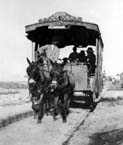RECIFE
Part A: 1867-1913 (pictures 01-11) [See Part B] [See Part C] [Return to the Introduction] Click on the pictures to see enlargements; "pc" = postcard. |
 |
(01) One of the locomotives built in the period 1866-1870 by Manning Wardle & Co. in Leeds for the Estrada de Ferro de Caxangá in Recife. They were said to be the world's first locomotives designed for operation on public streets. [Whitcombe Collection, Science Museum, London] |
 |
(02) A train of the E. F. de Caxangá on its trestle over the Rio Capibaribe. View is east toward Santo Antônio island [see map]. Date of the photograph is about 1900. [col. AM] |
 |
(03) Ponte d'Uchôa station on Av. Rui Barbosa on E.F.C.'s Apipucos line. The station was built in 1865, has been preserved and still stands today. [pc, col. AM] |
 |
(04) A ticket of the E.F.C. from 1900. [Julius Meili, Das Brasilianische Geldwesen, Zürich, 1903] |
 |
(05) A train of Recife's other suburban railway company, Trilhos Urbanos do Recife a Olinda e Beberibe. The photograph was apparently taken in Fundão [see map]. [col. AM] |
 |
(06) A ticket of the Ferro Carril de Pernambuco, which inaugurated the city's horsecar system in 1871. [Julius Meili, Das Brasilianische Geldwesen, Zürich, 1903] |
 |
(07) An F.C.P. tram on its line southwest to Afogados and Jiquiá (Giquiá) [see map]. Jiquiá was the location of Recife's first airfield, where the Graf Zeppelin landed in the 1930s. [col. AM] |
 |
(08) Recife horsecars ran left-hand, English-style, on two-way streets. Rua Victoria is called Rua 1º de Março today. [pc, col. AM] |
 |
(09) Praça da Independência on Santo Antônio island, about 1903. Note that both the tram and the pedestrians are traveling left-hand . . . [pc, col. AM] |
 |
(10) A horsecar crossing Ponte da Boa Vista [see map]. The plaques honor Emperor Dom Pedro II. [pc, col. AM] |
 |
(11) Arco de Santo Antônio in the Santo Antônio district. [pc, col. AM] |
Return to the Introduction
See Map